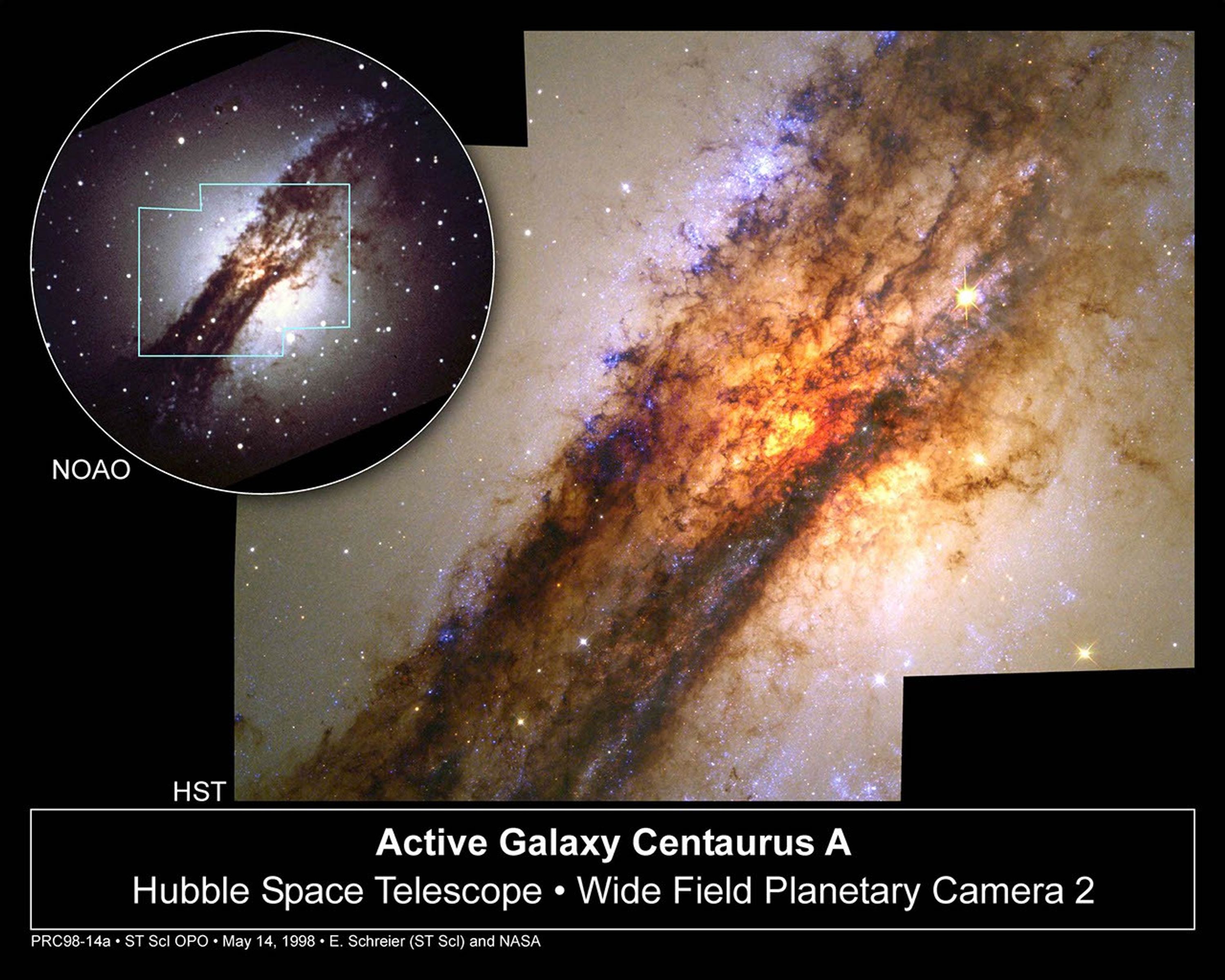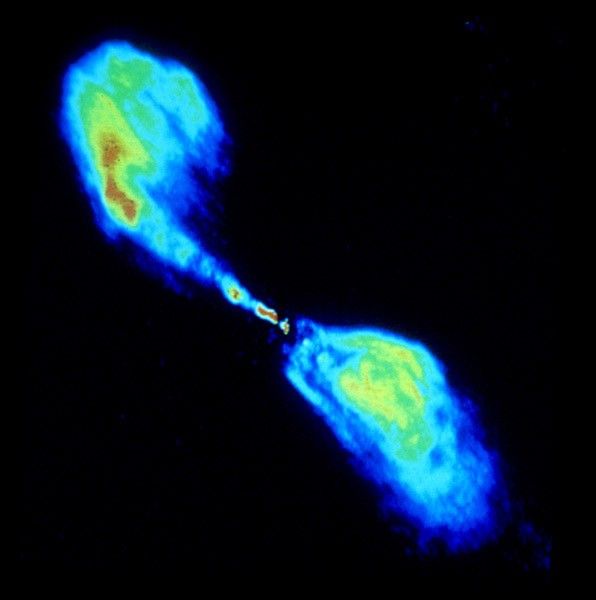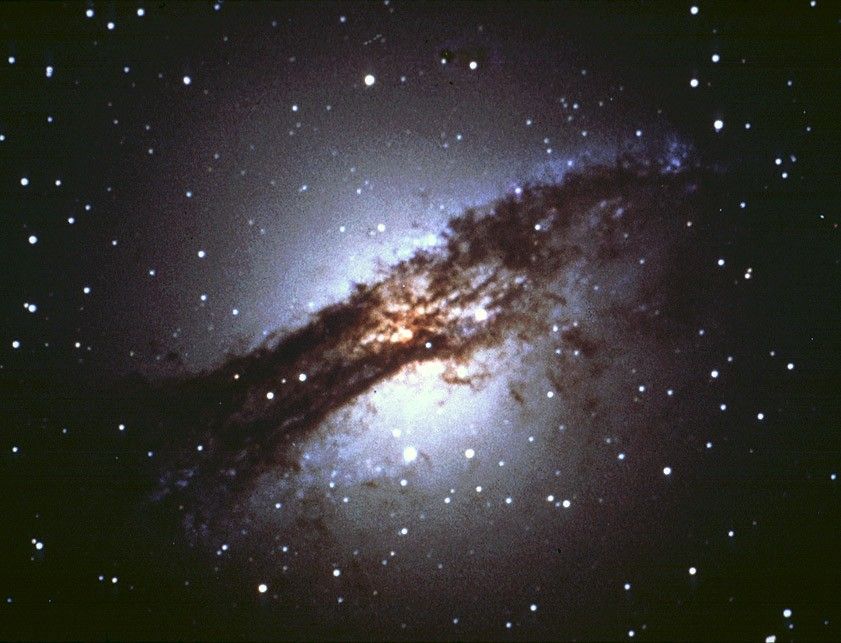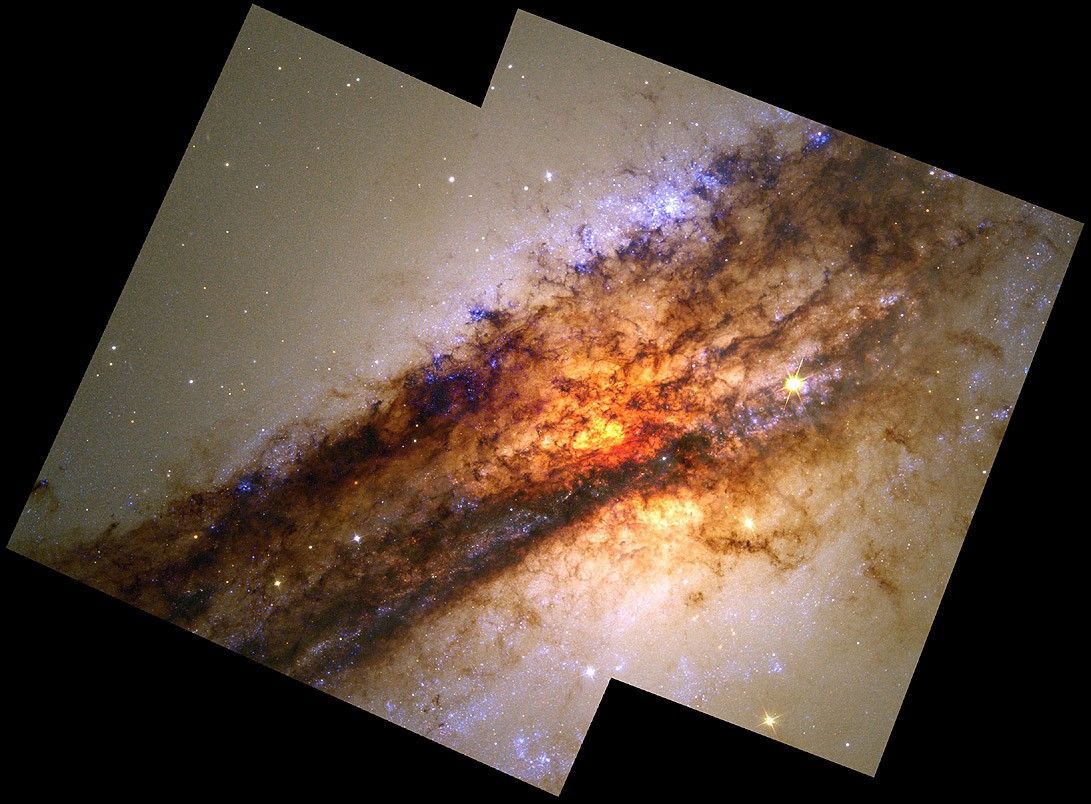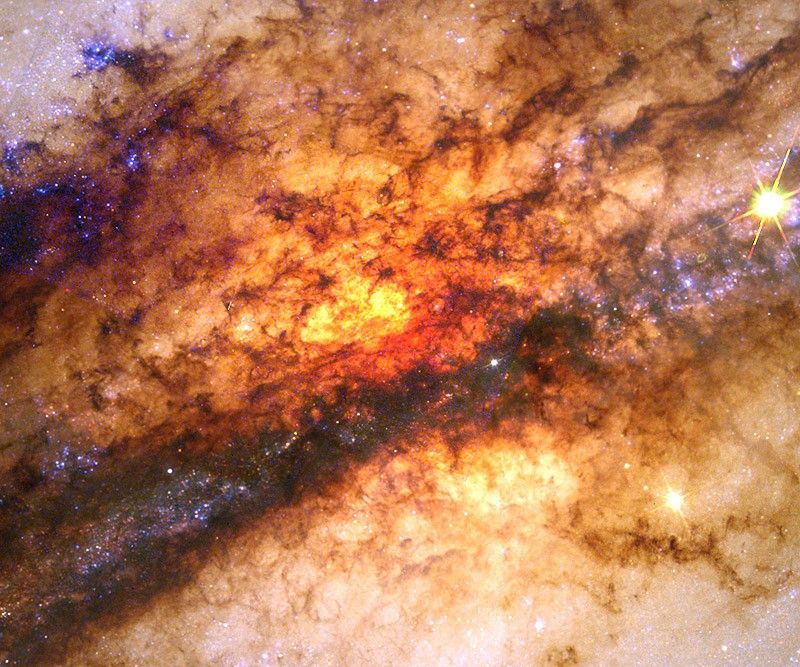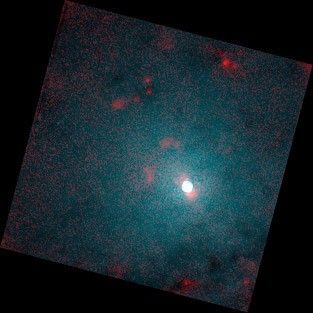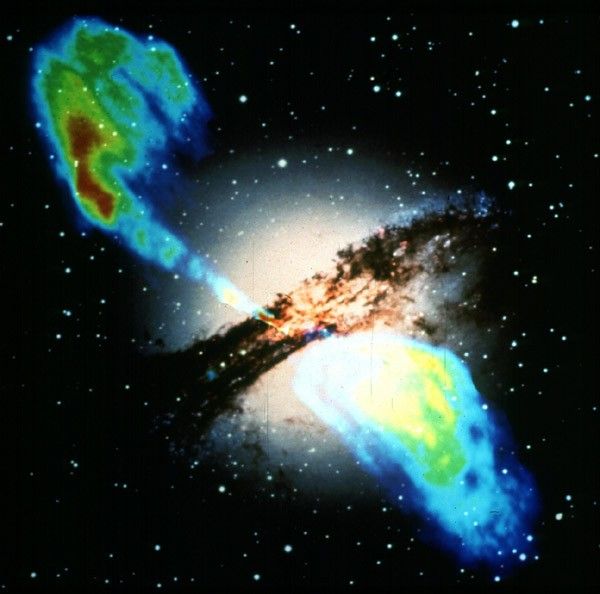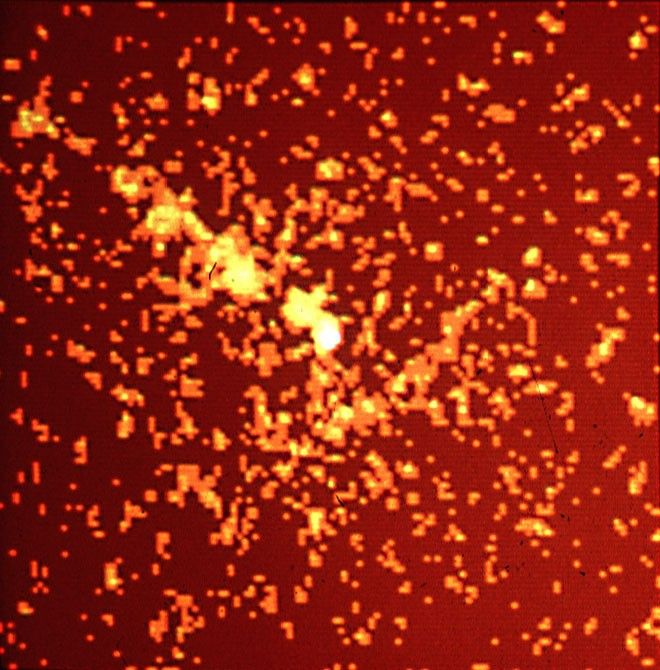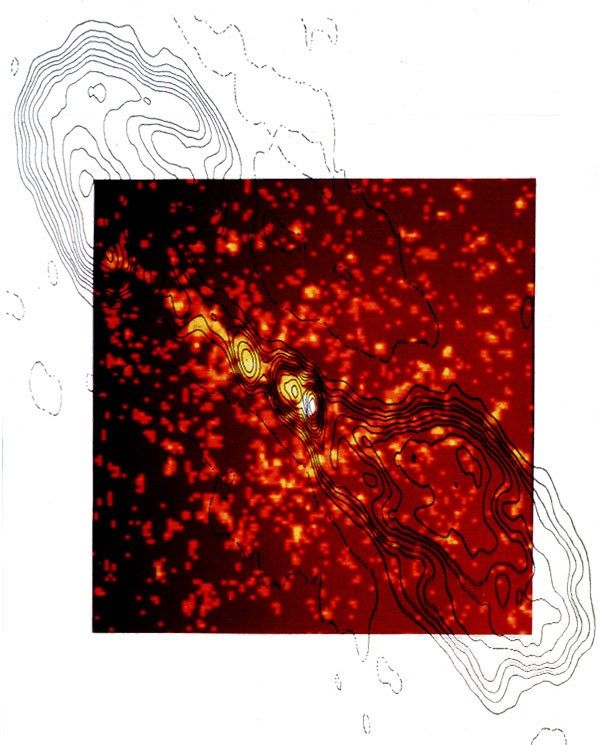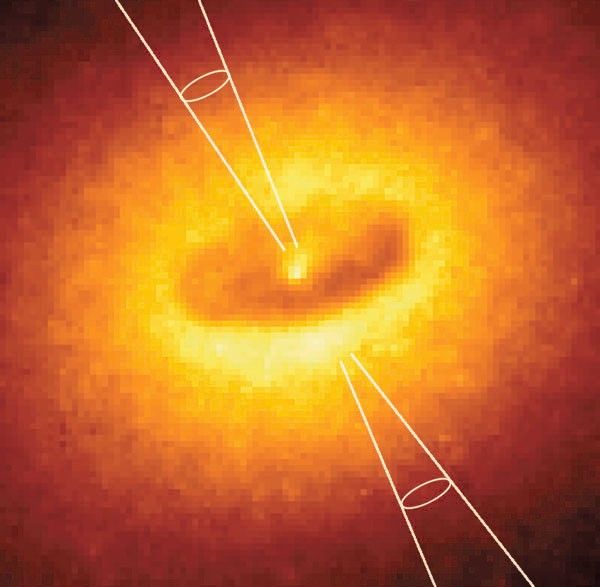Astronomers have obtained an unprecedented look at the nearest example of galactic cannibalism – a massive black hole hidden at the center of a nearby giant galaxy that is feeding on a smaller galaxy in a spectacular collision. Such fireworks were common in the early universe, as galaxies formed and evolved, but are rare today.
Although the cause-and-effect relationships are not yet clear, the views provided by complementary images from two instruments aboard NASA's Hubble Space Telescope are giving astronomers new insights into the powerful forces being exerted in this complex maelstrom. Researchers believe these forces may even have shifted the axis of the massive black hole from its expected orientation.
The Hubble wide-field camera visible image of the merged Centaurus A galaxy, also called NGC 5128, shows in sharp clarity a dramatic dark lane of dust girdling the galaxy. Blue clusters of newborn stars are clearly resolved, and silhouettes of dust filaments are interspersed with blazing orange-glowing gas. Located only 10 million light-years away, this peculiar-looking galaxy contains the closest active galactic nucleus to Earth and has long been considered an example of an elliptical galaxy disrupted by a recent collision with a smaller companion spiral galaxy.
Using the infrared vision of Hubble, astronomers have penetrated this wall of dust for the first time to see a twisted disk of hot gas swept up in the black hole's gravitational whirlpool. The suspected black hole is so dense it contains the mass of perhaps a billion stars, compacted into a small region of space not much larger than our Solar System.
Resolving features as small as seven light-years across, Hubble has shown astronomers that the hot gas disk is tilted in a different direction from the black hole's axis - like a wobbly wheel around an axle. The black hole's axis is identified by the orientation of a high-speed jet of material, glowing in X-rays and radio frequencies, blasted from the black hole at 1/100th the speed of light.
This gas disk presumably fueling the black hole may have formed so recently it is not yet aligned to the black hole's spin axis, or it may simply be influenced more by the galaxy's gravitational tug than by the black hole's.
"This black hole is doing its own thing. Aside from receiving fresh fuel from a devoured galaxy, it may be oblivious to the rest of the galaxy and the collision," said Ethan Schreier of the Space Telescope Science Institute, Baltimore, MD. Schreier and an international team of co-investigators used Hubble's Near Infrared Camera and Multi-Object Spectrometer to probe deeper into the galaxy's mysterious heart than anyone has before.
The hot gas disk viewed by Hubble investigators is perpendicular to the galaxy's outer dust belt, while the black hole's own internal accretion disk of superhot gas falling into it is tilted approximately diagonally to these axes.
"We have found a complicated situation of a disk within a disk within a disk, all pointing in different directions," Schreier said. It is not clear if the black hole was always present in the host galaxy or belonged to the spiral galaxy that fell into the core, or if it is the product of the merger of a pair of smaller black holes that lived in the two once-separate galaxies.
Having an active galaxy just 10 million light-years away from Earth rather than hundreds of millions or billions of light-years distant offers astronomers a unique laboratory for understanding the elusive details of the behavior of supermassive black holes as fueled by galaxy collisions.
"Though Hubble has seen hot gas disks around black holes in other galaxies, the infrared camera has for the first time allowed us to peer at this relatively nearby, very active, but obscured black hole region," Schreier added.
The team of astronomers is awaiting further Hubble data to continue its study of the disk, as well as ground-based spectroscopic observations to measure the velocity of entrapped material around the black hole. This will allow the astronomers to better calculate the black hole's mass. The current results are scheduled to appear in the June 1, 1998 issue of Astrophysical Journal Letters.
BACKGROUND INFORMATION: KEY EVENTS IN THE HISTORY OF CENTAURUS A1847:
Sir John Herschel was the first to report observations of what we now know as NGC 5128, or its radio name Centaurus A. In his "Outlines of Astronomy," published in 1849, Herschel described it as "two semi-ovals of elliptically formed nebula appearing to be cut asunder and separated by a broad obscure band parallel to the larger axis of the nebula, in the midst of which a faint streak of light parallel to the sides of the cut appears."
1848-1949: Despite Herschel's observation, astronomers paid little attention to Centaurus A for about 100 years because they considered it another one of those nebulous, fuzzy objects originally thought to be in our own galaxy. Even Edwin Hubble called it a nebulous object. Later astronomers with more powerful telescopes identified many of these objects as galaxies. Centaurus A also was largely ignored because of the lack of large optical telescopes in the southern hemisphere, where this galaxy can be seen.
1949: Astronomers had just developed another technique to study celestial objects besides optical light: special instruments to collect radio waves. Using an 80-foot radio antenna at Dover Heights, Australia and radio waves reflected off the nearby sea, astronomers John Bolton, G. Stanley, and Bruce Slee were the first to identify Centaurus A as a powerful radio galaxy. Radio waves from Centaurus A were among the first to be linked to an extragalactic object.
1954: Studying Centaurus A with telescopes at Palomar Observatory in California, Walter Baade and Rudolph Minkowski confirmed that it is a galaxy. The pair also proposed that the peculiar structure of Centaurus A - with a bar of dark dust bisecting the galaxy - is the result of a merger between two galaxies, a giant elliptical and a small spiral.
1969-1971: Stuart Bowyer, using a sounding rocket, detected X-rays emanating from Centaurus A. In late 1970, the UHURU satellite confirmed that the X-rays were indeed associated with the galaxy. In 1971, Bill Kunkel and Hale Bradt used a telescope at the Cerro Tololo Inter-American Observatory (CTIO) in Chile to observe infrared light originating from a compact source in the galaxy's core. X-ray observations in the early 1970s with the Astronomical Netherlands Satellite (ANS) and the Orbiting Solar Observatory (OSO-7) showed changes in the intensity of X-ray emissions. Significant changes over a very short time indicated that the emission source was confined to a small region of space. The results suggested that a black hole could be the culprit.
1975: Looking at the galaxy in visible light with a CTIO telescope, Victor Blanco discovered a faint jet out in the galaxy. He also noted blue stellar objects in this region.
1975-76: Using information from the SIGMA satellite and high-flying research balloons, Josh Grindlay and R.D. Hall detected gamma ray emissions which were probably coming from the nucleus.
Late 1970s: John Graham, using a CTIO telescope, found a series of faint shells of gas in the outer regions of the galaxy. These shells could have been produced by collisions of gas from a galaxy merger.
1979: Using the Einstein Observatory, Ethan Schreier discovered an X-ray jet emanating from the nucleus of Centaurus. A. Working with Eric Feigelson and Jack Burns, Schreier used the Very Large Array in New Mexico to find the jet's radio counterpart.
1981: With the Einstein Observatory, Schreier and Feigelson also observed extended X-ray emissions in the galaxy, including ridges of emissions along the north and south edges of the dust lane.
1996: Schreier used the Hubble Space Telescope's Wide Field and Planetary Camera 2 (WFPC2) to study the dust lane's polarization properties and the distribution of young stars along its northern edge. The young, blue stars provided further proof that Centaurus A, an elliptical galaxy, merged with a spiral galaxy. Elliptical galaxies such as Centaurus A would not have had enough dust and gas to form clusters of new stars.
1997: Kenneth Kellermann, Anton Zensus, and Marshall Cohen, using the Very Long Baseline Array (VLBA) in New Mexico, observed that the core of Centaurus A is only 10 light-days across, making it the smallest known extragalactic radio source. They also noted that the energy produced by this source varies in intensity every day. This core has a mass of about 100 million suns.
1997-98: Schreier used WFPC2 to further examine the nucleus and the bright, young stars. Since WFPC2 cannot peer through the dusty core, Schreier and Alessandro Marconi turned to the Hubble telescope's Near Infrared Camera and Multi-Object Spectrometer (NICMOS) to explore the core. They found a very compact nucleus and also discovered a central, warped disk. The disk could have been warped by a collision with another galaxy.

























